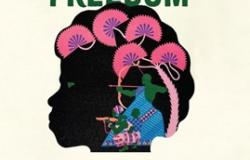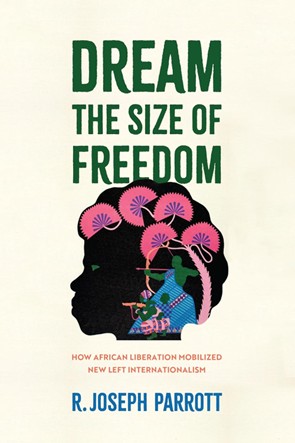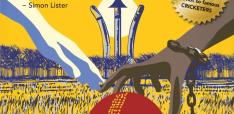Book Review - Dream the Size of Freedom: How African Liberation Mobilized New Left Internationalism

Dream the Size of Freedom: How African Liberation Mobilized New Left Internationalism by R. Joseph Parrott. Philadelphia: University of Pennsylvania Press, 2025. 392 pp., £36.00 hardcover 9781512827675, e-book 9781512827682
The Vietnam War gave rise to the largest protest movement in history as hundreds of thousands of U.S. citizens took to the streets to express their opposition to U.S. intervention in Southeast Asia in the 1960s and 1970s. Yet, as R. Joseph Parrott illustrates in his engrossing book, Dream the Size of Freedom: How African Liberation Mobilized New Left Internationalism, operating in the shadow of the anti-Vietnam war protests, U.S. activists extended their gaze to other locales. Revolutionary leaders in Mozambique, Angola, and Guinea-Bissau “believed their global visions of liberation could have a transformative effect on U.S. politics,” Parrott writes, especially concerning decolonization. Yet, these revolutionary nationalists could not do it on their own. Framing their battle as one for self-determination, the Mozambique Liberation Front (FRELIMO), the Popular Movement for the Liberation of Angola (MPLA), and the African Party for the Independence of Guinea and Cabo Verde (PAIGC) constructed a truly international “anti-imperial front” that, particularly in the United States, “challenged the [U.S.] alliance with Portugal while raising barriers to reactionary interventions—from the ground up,” Parrott writes (4). As for U.S.-based activists, Lusophone Africa offered a viable alternative to North Vietnam, China, or Cuba. “The more palatable anti-colonial struggles occurring in Lusophone Africa created a safer space to explore tricontinental ideas,” Parrott argues (279). “The Lusophone revolutions never displaced Vietnam as the preeminent radical cause,” Parrott admits, “but they became complementary, secondary fronts in the domestic war against U.S. imperialism” (127). The New Left, which emerged in the early 1960s, serving as a central hub for civil rights, free speech, and antiwar activism, also played a key role in the transnational anti-colonial movement. U.S. activists taking part in this campaign were guided by the ideals of “New Left Internationalism,” which sought “global racial equality, the preservation of authentic cultures, economic development projects, the danger of global wars, and the need for more democratic formulations of policymaking,” according to Parrott (5). As New left activists engaged with African liberation movements, their thinking evolved, taking on a more transnational perspective. Parrott suggests that New Left Internationalism borrowed generously from the tricontinentalism of the Global South with its “critiques of capitalism and empire, concern with the North-South divide, and a willingness to accept revolution,” while also discarding the paternalism of earlier interactions between the Global North and Global South (190). Regarding the latter point, Parrott describes Global North activists as “playing supporting roles in a global revolution, acting almost as quasi-ambassadors to the future governments of independent states” (281).
The New Left, which emerged in the early 1960s, serving as a central hub for civil rights, free speech, and antiwar activism, also played a key role in the transnational anti-colonial movement. U.S. activists taking part in this campaign were guided by the ideals of “New Left Internationalism,” which sought “global racial equality, the preservation of authentic cultures, economic development projects, the danger of global wars, and the need for more democratic formulations of policymaking,” according to Parrott (5). As New left activists engaged with African liberation movements, their thinking evolved, taking on a more transnational perspective. Parrott suggests that New Left Internationalism borrowed generously from the tricontinentalism of the Global South with its “critiques of capitalism and empire, concern with the North-South divide, and a willingness to accept revolution,” while also discarding the paternalism of earlier interactions between the Global North and Global South (190). Regarding the latter point, Parrott describes Global North activists as “playing supporting roles in a global revolution, acting almost as quasi-ambassadors to the future governments of independent states” (281).
The American Committee on Africa (ACOA), founded by civil rights activist George Houser in 1953, stood at the center of early efforts to create a transnational anti-colonial movement. For Angolan rebel leader Holden Roberto, who created the Union of Angolan People (UPA), “ACOA became a primary organ for communicating with the West,” Parrott writes (26). At the same time, Roberto’s reliance on ACOA also “revealed the limitations of U.S. solidarity” prior to 1961, according to Parrott. With Houser at the helm, ACOA assumed its founder’s Cold War liberal anti-communist beliefs and a reliance on non-violent civil disobedience to achieve change. Thus, ACOA, while acknowledging the necessity of violence, tended to disapprove of wars of liberation. As a result, Roberto “was an ideal ally” for ACOA, which hoped the former’s nationalism might check revolutionary violence and the growth of communism (27). When John F. Kennedy entered the White House, ACOA worked with the Africa Bureau, “but an inability to make inroads at the highest levels of policymaking limited its direct influence,” Parrott writes (30). Ultimately, opposition from North Atlantic Treaty Organization (NATO) allies, Britain and France, derailed the Kennedy administration’s efforts to promote gradual self-determination in Angola.
Besides Roberto, a united front of parties from multiple nations in Africa, known as the Conference of Nationalist Organizations of the Portuguese Colonies (CONCP), more leftist and communist-friendly than the UPA, took on a leadership role in the Angolan revolutionary movement. CONCP’s ideological bent, along with its willingness to resort to violence, meant that the UPA remained the preferred ally of Western activists. Faced with failure in the United States, and sectarian conflicts between the UPA and CONCP, Roberto lost status as “the militarization of Lusophone nationalism,” in the words of Parrott, required new leadership. Eduardo Mondlane of Mozambique, leader of CONCP-affiliated party FRELIMO, stepped up to take on this role, which ultimately helped transform the focus of the transnational grassroots networks due to the rise in stature of “the revolutionary, socialist visions pursued by CONCP parties in Mozambique and Guinea” (59-60). Parrott argues that Mondlane, who for a time taught sociology at Syracuse University, “helped FRELIMO translate its goals for militant, anti-imperial revolution into terms more amenable to Western audiences—global justice, equality, and even human rights” (72). Thus, as FRELIMO in Mozambique and the PAIGC in Guinea-Bissau found success on the battlefield, they also “built new social, educational, and economic programs that contrasted their socialist programs with the underdeveloped imperial infrastructure,” especially in rural regions, and allowed the two parties “to claim status as governments-in-waiting" in the international arena (82). Even so, the limits of the Cold War, as well as a concerted propaganda campaign carried out by Portugal and other white minority-led governments in Africa, hampered the anti-colonial activists’ pursuits.
By the mid-to-late 1960s, youth activists transformed the U.S.-based anti-colonial movement. In 1961, Margaret Flory, the Presbyterian secretary for student work of the Commission on World Mission of the National Student Christian Federation, helped create the Frontier Internship in Mission (FIM), which sent American youth to foreign lands, mostly in the Global South, for two-year stints. As Parrott argues, “Flory’s FIM upended the traditional goals of Christian mission by converting progressive Americans to Global South ideas,” including, controversially, armed resistance (110). During a meeting in Zambia in 1967, the FIM produced a statement in which the participants “accepted the three-pronged vision of revolution championed by CONCP,” in the words of Parrott, which included domestic reconstruction, militant insurrection, and protests abroad (118). Whereas ACOA focused its energies on convincing liberals and civil rights activists of the common ground between their domestic concerns and African issues, FIMers targeted young Americans through education and by amplifying the voices of African revolutionaries through speaking tours. Myriad other groups, both secular and faith-based, followed a similar trajectory. For its part, ACOA remained important as an information clearinghouse and through its funding of myriad other organizations.
After more than a decade of activism, the transnational anti-colonial movement found success in the United States. On 20 December 1975, the U.S. Senate passed an amendment to the Department of Defense appropriations bill introduced by John Tunney (D-CA) that prohibited additional covert aid to Angola’s anti-MPLA factions. Early the following year, Dick Clark (D-IA) secured passage of an amendment to the U.S. Arms Export Control Act of 1976 barring aid to private organizations involved in military and paramilitary actions in Angola. Viewing the former vote as a smashing success, Parrott attributes the outcome less to anti-interventionist sentiment in the post-Vietnam War era than to the CONCP-aligned solidarity network, which “was well-positioned to respond” after years of preparations (247-248). Yet, the Cold War consensus endured.
Ironically, anti-colonists’ victories produced a conservative counterattack as President Gerald Ford’s timidity led to a search for someone to lead a reinvigorated anti-communist crusade. “Angola revived a popular anti-communism even as it handed the internationalists what was arguably their greatest victory after Vietnam,” according to Parrott (261). The renewed anti-communism spearheaded by Reagan and other New Right activists and organizations proved that “no new foreign policy consensus” existed, even after the successful passage of the Tunney and Clark Amendments (268). Yet, because of Parrott’s meticulous research into the diverse anti-colonial coalition of the 1960s and 1970s, we now know that Reagan’s efforts to rollback communism amid the New Cold War of the 1980s had to contend with a still strong New Left Internationalism that confronted the president from Latin America to South Africa and beyond.
Dr. Brian S. Mueller teaches history at the University of Wisconsin-Milwaukee.


